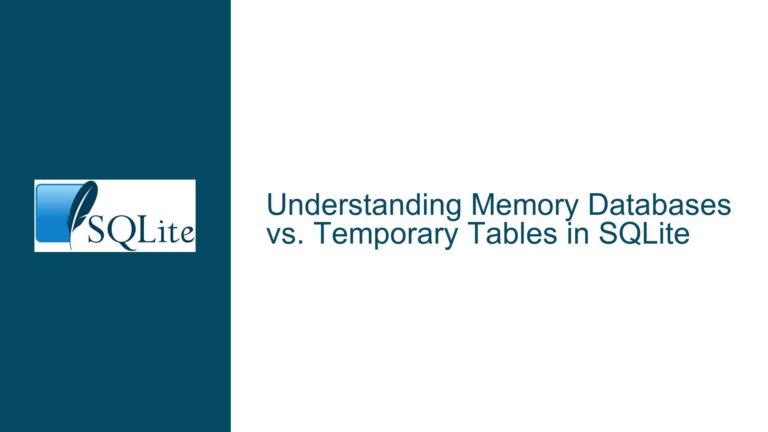and Fixing xBestIndex Malfunction in SQLite Virtual Tables
Issue Overview: xBestIndex Malfunction in JOIN Operations with Virtual Tables
The core issue revolves around a malfunction in the xBestIndex method of a custom SQLite virtual table when used in a JOIN operation. The virtual table, named StdVectorHash, works correctly when used in an IN clause but fails when incorporated into a JOIN operation. The error message explicitly points to a malfunction in the xBestIndex method, with SQLite indicating that the non-zero argvIdx values must be contiguous. This error is rooted in the way the xBestIndex method is implemented, particularly in how it handles constraints and their corresponding argvIndex values.
The virtual table StdVectorHash is defined with two columns: value and collection hidden. The xBestIndex method is responsible for determining the best way to access the virtual table based on the constraints provided by the SQL query. In this case, the method is designed to handle equality constraints (SQLITE_INDEX_CONSTRAINT_EQ) on both columns. However, the implementation contains a critical error in how it assigns argvIndex values to the constraints, leading to the malfunction when the virtual table is used in a JOIN.
The error message "non-zero argvIdx values must be contiguous" suggests that SQLite expects the argvIndex values assigned to constraints to be sequential and without gaps. In the provided implementation, the argvIndex values are not assigned correctly, leading to the error. Specifically, the code overwrites the argvIndex value for the first constraint (aConstraintUsage[0]) multiple times, which violates the contiguity requirement.
Possible Causes: Misassignment of argvIndex Values and Constraint Handling
The primary cause of the xBestIndex malfunction lies in the incorrect assignment of argvIndex values within the BestIndex function. The function is designed to iterate over the constraints provided by the SQL query and assign argvIndex values based on the column being constrained. However, the implementation incorrectly assigns these values to aConstraintUsage[0] regardless of the constraint being processed. This results in the argvIndex values being overwritten, leading to non-contiguous assignments.
In the provided code, the BestIndex function processes constraints for both columns of the virtual table (value and collection hidden). When a constraint is encountered on the value column (column index 0), the function sets argvIndex to 2 and marks the constraint as usable. However, when a constraint is encountered on the collection hidden column (column index 1), the function sets argvIndex to 1, again assigning it to aConstraintUsage[0]. This overwrites the previous assignment, resulting in a non-contiguous sequence of argvIndex values.
Additionally, the function resets idxNum to 0 at the end, which may not be necessary and could potentially interfere with the correct operation of the virtual table. The idxNum variable is used to communicate the chosen indexing strategy back to SQLite, and resetting it to 0 may cause SQLite to misinterpret the intended strategy.
Another potential cause of the issue is the handling of IN clauses in virtual tables. As mentioned in the discussion, IN clauses are handled differently in virtual tables compared to standard tables. By default, SQLite will call the virtual table multiple times with equality constraints for each value in the IN clause. However, this behavior can be optimized using the sqlite3_vtab_in function, which allows the virtual table to process all values in the IN clause at once. While this is not directly related to the xBestIndex malfunction, it is worth considering when designing virtual tables that may be used in IN clauses.
Troubleshooting Steps, Solutions & Fixes: Correcting argvIndex Assignment and Optimizing Constraint Handling
To resolve the xBestIndex malfunction, the BestIndex function must be corrected to properly assign argvIndex values to constraints without overwriting previous assignments. This involves ensuring that each constraint is assigned a unique and contiguous argvIndex value. Additionally, the function should avoid resetting idxNum at the end, as this may interfere with the correct operation of the virtual table.
The corrected implementation of the BestIndex function should look like this:
static int BestIndex(sqlite3_vtab* tab, sqlite3_index_info* pIdxInfo) {
pIdxInfo->idxNum = 0;
pIdxInfo->estimatedCost = 100;
pIdxInfo->estimatedRows = 1000;
int argvIndex = 1; // Start assigning argvIndex values from 1
const struct sqlite3_index_info::sqlite3_index_constraint* pConstraint;
pConstraint = pIdxInfo->aConstraint;
for (int i = 0; i < pIdxInfo->nConstraint; i++, pConstraint++) {
if (!pConstraint->usable) {
continue;
}
if (pConstraint->op != SQLITE_INDEX_CONSTRAINT_EQ) {
continue;
}
switch (pConstraint->iColumn) {
case 0: // value column
pIdxInfo->idxNum = 1;
pIdxInfo->idxFlags = SQLITE_INDEX_SCAN_UNIQUE;
pIdxInfo->aConstraintUsage[i].argvIndex = argvIndex++;
pIdxInfo->aConstraintUsage[i].omit = true;
pIdxInfo->estimatedCost = 1;
pIdxInfo->estimatedRows = 1;
break;
case 1: // collection hidden column
pIdxInfo->aConstraintUsage[i].argvIndex = argvIndex++;
pIdxInfo->aConstraintUsage[i].omit = true;
break;
default:
break;
}
}
if (pIdxInfo->nOrderBy == 1) {
pIdxInfo->orderByConsumed = 1;
}
return SQLITE_OK;
}
In this corrected implementation, the argvIndex variable is used to assign unique and contiguous values to each constraint. The argvIndex value is incremented after each assignment, ensuring that no two constraints share the same argvIndex value. This satisfies SQLite’s requirement that argvIndex values must be contiguous.
Additionally, the function no longer resets idxNum at the end, allowing SQLite to correctly interpret the chosen indexing strategy. The idxNum variable is set to 1 when a constraint on the value column is encountered, indicating that the virtual table should use a unique scan for that constraint.
To further optimize the virtual table for use in IN clauses, consider implementing the sqlite3_vtab_in function. This function allows the virtual table to process all values in an IN clause at once, rather than being called multiple times with individual equality constraints. Implementing sqlite3_vtab_in can improve the performance of queries that use the virtual table in IN clauses.
Here is an example of how to implement sqlite3_vtab_in:
static int VTabIn(sqlite3_vtab* tab, int iCons, int bHandle) {
// Implement logic to handle IN clause processing
return SQLITE_OK;
}
The VTabIn function should be registered with the virtual table module during initialization. This allows SQLite to call the function when processing IN clauses, enabling the virtual table to handle multiple values efficiently.
In conclusion, the xBestIndex malfunction in the StdVectorHash virtual table is caused by incorrect assignment of argvIndex values and improper handling of constraints. By correcting the BestIndex function and optionally implementing sqlite3_vtab_in, the virtual table can be made to work correctly in both JOIN and IN operations. These changes ensure that the virtual table adheres to SQLite’s requirements for constraint handling and indexing, allowing it to function as intended in a variety of query scenarios.






